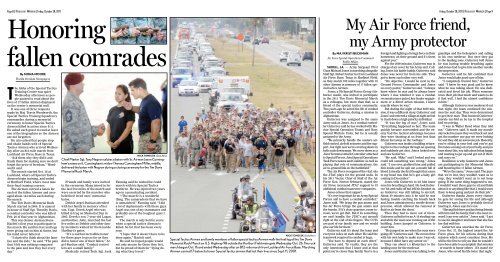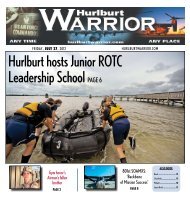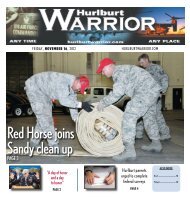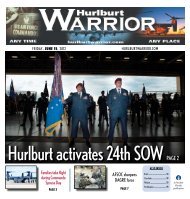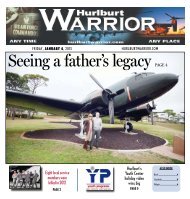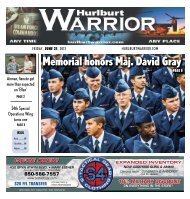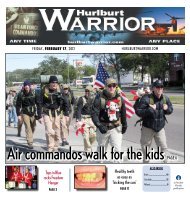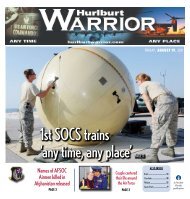doctor leaves private practice to become airman ... - Hurlburt Warrior
doctor leaves private practice to become airman ... - Hurlburt Warrior
doctor leaves private practice to become airman ... - Hurlburt Warrior
You also want an ePaper? Increase the reach of your titles
YUMPU automatically turns print PDFs into web optimized ePapers that Google loves.
Page 8 | <strong>Hurlburt</strong> <strong>Warrior</strong> | Friday, Oc<strong>to</strong>ber 28, 2011 Friday, Oc<strong>to</strong>ber 28, 2011 | <strong>Hurlburt</strong> <strong>Warrior</strong> | Page 9<br />
Honoring<br />
fallen comrades<br />
By MONA MOORE<br />
Florida Freedom Newspapers<br />
The lobby of the Special Tactics<br />
Training Center was quiet<br />
Wednesday afternoon as people<br />
paused <strong>to</strong> read about the<br />
lives of 17 fallen Airmen displayed<br />
on the center’s memorial wall.<br />
It was one of three requests<br />
made by Maj. Travis Woodworth, the<br />
Special Tactics Training Squadron’s<br />
commander, during a memorial<br />
ceremony <strong>to</strong> honor Special Tactics<br />
Airmen killed in action since 9/11.<br />
He asked each guest <strong>to</strong> read at least<br />
one of the biographies so the Airmen<br />
are not forgotten.<br />
He also asked that people s<strong>to</strong>p<br />
and shake hands with 18 Special<br />
Tactics Airmen who arrived Wednesday<br />
after an 812-mile march from<br />
Lackland Air Force Base in Texas.<br />
“Ask them why they did it and<br />
thank them for making sure we don’t<br />
forget the price of freedom,” Woodworth<br />
said.<br />
The march started Oct. 16 at<br />
Lackland, where all Special Tactics<br />
Airmen begin training, and ended<br />
at <strong>Hurlburt</strong> Field, where most take<br />
their final training courses.<br />
The Airmen carried a ba<strong>to</strong>n for<br />
each of the fallen Airmen and averaged<br />
about 144 miles each during<br />
the march.<br />
The Tim Davis Memorial Ruck<br />
March started in 2009. It is named<br />
in honor of Staff Sgt. Timothy Davis,<br />
a combat controller who was killed<br />
Feb. 20 of that year in Afghanistan.<br />
This was Senior Airman S<strong>to</strong>ne<br />
Hazlett’s first year <strong>to</strong> participate in<br />
the march. He said his feet and legs<br />
were giving out on him at times, but<br />
his mind never faltered.<br />
“I started <strong>to</strong> think about the families<br />
and the kids,” he said. “The pain<br />
that I felt was nothing compared<br />
<strong>to</strong> the pain and loss they feel every<br />
day.”<br />
nick <strong>to</strong>mecek | Daily News<br />
Chief Master Sgt. Tony Negron salutes a ba<strong>to</strong>n with Sr. Airman Jason Cunningham’s<br />
name on it. Cunningham’s widow Theresa Cunningham Miller, middle,<br />
delivered the ba<strong>to</strong>n with Negron during a closing ceremony for the Tim Davis<br />
Memorial Ruck March.<br />
Friends and family were invited<br />
<strong>to</strong> the ceremony. Many joined in for<br />
the last five miles of the march and<br />
were escorted by the marcher who<br />
held their loved ones’ memorial<br />
ba<strong>to</strong>n.<br />
Debbie Argel-Bastian attended<br />
with her family in memory of her<br />
son, Capt. Derek Argel who was<br />
killed in Iraq on Memorial Day in<br />
2005. Derek’s son, 7-year-old Logan,<br />
and brother, John, marched the last<br />
five miles as Debbie and other family<br />
members waited for them inside<br />
<strong>Hurlburt</strong>’s gates.<br />
“It’s a sad but incredible honor<br />
for these guys <strong>to</strong> go as far as they<br />
did <strong>to</strong> honor one of their fallen,” Argel-Bastian<br />
said. “Combat controllers<br />
are a small family.”<br />
Medically retired Tech. Sgt. Jack<br />
Fanning said he wished he could<br />
march with his Special Tactics<br />
brethren. He was injured two years<br />
ago in a parachuting accident.<br />
“(The march) is a wonderful<br />
thing. The camaraderie that we have<br />
is unmatched,” Fanning said. “I did<br />
a lot of deployments with these guys.<br />
Argel was one of my teammates and<br />
probably one of the <strong>to</strong>ughest guys I<br />
knew.”<br />
The march is only held in years<br />
when a special tactics Airman is<br />
killed. So far, that has been every<br />
year.<br />
“I hope that it doesn’t have <strong>to</strong> be<br />
done again,” Hazlett said.<br />
He said he hoped people would<br />
not only mourn for those they lost,<br />
but be proud of them for “dying doing<br />
what they loved.”<br />
nick <strong>to</strong>mecek | Daily News<br />
Special Tactics Airmen and family members of fallen special tactics Airmen walk the final leg of the Tim Davis<br />
Memorial Ruck March on U.S. Highway 98 outside the <strong>Hurlburt</strong> Field main gate Wednesday Oct. 26. The ruck<br />
march began Oct. 16 and ended Wednesday after an 812-mile march from Lackland Air Force Base. Marching<br />
Airmen carried 17 ba<strong>to</strong>ns <strong>to</strong> honor Special Tactics airmen that lost their lives since Sept. 11, 2001.<br />
My Air Force friend,<br />
my Army protec<strong>to</strong>r<br />
By Maj Kristi Beckman<br />
Air Force Special Operations Command<br />
Public Affairs<br />
Slidell, La. — Army Sergeant First<br />
Class Michael Jones is marching alongside<br />
Staff Sgt. Robert Gutierrez from Lackland<br />
Air Force Base, Texas <strong>to</strong> <strong>Hurlburt</strong> Field,<br />
as they march 812 miles <strong>to</strong>gether with 16<br />
other Airmen in memory of 17 fallen special<br />
tactics Airmen.<br />
Jones, a 7th Special Forces Group (Airborne)<br />
medic, was invited <strong>to</strong> participate<br />
in the 2011 Tim Davis Memorial March<br />
as a colleague, but more than that, as a<br />
friend of the special tactics community.<br />
Two years ago he saved the life of combat<br />
controller Gutierrez, during a mission in<br />
Afghanistan.<br />
Gutierrez was assigned <strong>to</strong> the same<br />
Army unit as Jones. As a combat controller<br />
Gutierrez said he has worked with Marine<br />
Special Operation Teams and Navy<br />
Special Warfare Units, but he is usually<br />
assigned <strong>to</strong> the Army.<br />
“We primarily handle the austere airfield<br />
control, airfield seizures and fire support<br />
, but right now we’re covering down on<br />
both ends downrange. We cover down as a<br />
Joint Terminal Attack Controller attached<br />
<strong>to</strong> Special Forces, Joint Special Operations<br />
Task Force teams and Coalition; as well as<br />
playing that role of communications, the<br />
air-<strong>to</strong>-ground link on the battlefield.”<br />
The Air Force recognized the vital role<br />
the JTAC plays for the ground units. In<br />
his 2011 Vec<strong>to</strong>r, Chief of Staff of the Air<br />
Force Gen. Nor<strong>to</strong>n Schwartz, stated the<br />
Air Force increased JTAC support <strong>to</strong> 33<br />
additional combat maneuver companies.<br />
Jones echoes that support.<br />
“It’s very important for an Army Special<br />
Forces unit <strong>to</strong> have a combat controller,”<br />
Jones said. “We bring the gun ammo and<br />
the Air Force brings the gun ammo and<br />
the bombs. If it’s close quarters, room-<strong>to</strong>room,<br />
we’ve got that. But if its something<br />
we can’t handle, the JTAC’s got aircraft<br />
right at the end of his fingers. The CCTs<br />
are part of our family now and we would<br />
give our life for them.”<br />
Gutierrez said it’s about the team and<br />
everyone relies on each other. He said the<br />
teamwork required in combat is huge.<br />
“You have <strong>to</strong> depend on each other,”<br />
Gutierrez said. “In reality, they are the<br />
only Americans that I know and at that<br />
point you’re closer than family. You’re in a<br />
foreign land fighting a foreign force in their<br />
home<strong>to</strong>wn, on their ground and it’s them<br />
against you.”<br />
For the 2009 mission, Gutierrez was in<br />
charge of air cover for his Army unit. Calling<br />
Jones his battle buddy, Gutierrez said<br />
Jones was never far from his side. They<br />
got <strong>to</strong> know each other very well.<br />
“On objective, I would be next <strong>to</strong> the<br />
Ground Forces Commander and Jones<br />
on every patrol,” Gutierrez said. “I always<br />
knew where he was and he always knew<br />
where I was whether it was a combat<br />
reconnaissance patrol, key leader engagement<br />
or a direct action mission, I knew<br />
exactly where he was.”<br />
But during the night of that 2009 mission,<br />
it was a different s<strong>to</strong>ry. Gutierrez’ and<br />
Jones’ unit entered a village at night on foot<br />
<strong>to</strong> track down a high-priority individual.<br />
“It was the fog of war,” Jones said.<br />
“Everything happened so fast. The team<br />
quickly became surrounded and the enemy<br />
had the tactical advantage because<br />
they were shooting at us from less than<br />
fifteen feet away on the roof<strong>to</strong>ps.”<br />
Gutierrez was inside a building returning<br />
fire <strong>to</strong> the roof<strong>to</strong>ps through an opening<br />
and suddenly got shot. Jones looked over<br />
and saw Gutierrez.<br />
“He said, ‘Mike!’ and I looked and you<br />
could tell something was wrong,” Jones<br />
said. “I ran over, grabbed him and pulled<br />
him inside and he spit out a mouth full of<br />
blood. Literally the first thought that came<br />
<strong>to</strong> my head was that he’s got a baby girl<br />
coming in December.”<br />
Jones tells Gutierrez <strong>to</strong> let him know<br />
once his breathing is hard. He <strong>to</strong>ok Gutierrez’<br />
kit and radio off but left his headset on<br />
as Gutierrez was still talking <strong>to</strong> aircraft.<br />
About 30 minutes in<strong>to</strong> it he said he was<br />
having trouble catching his breath back<br />
and Jones administered a needle decompression,<br />
which allowed the removal of<br />
fluid or air from the chest.<br />
Then they had <strong>to</strong> move out of there.<br />
Gutierrez called in for an A-10 strafing run<br />
and while the team was running out of the<br />
building, Jones jumped on Gutierrez <strong>to</strong><br />
cover him.<br />
“He jumped on me when the runs were<br />
going off,” Gutierrez said. “He covered me<br />
with his own body <strong>to</strong> make sure I was ok,<br />
because I didn’t have any armor on.”<br />
They ran about 1.5 kilometers <strong>to</strong> the<br />
landing zone for the medevac.<br />
Jones said Gutierrez was talking <strong>to</strong> the<br />
gunships and the helicopters and calling<br />
in his own medevac. But once they got<br />
<strong>to</strong> the landing zone, Gutierrez <strong>to</strong>ld Jones<br />
he was having trouble breathing again<br />
and Jones had <strong>to</strong> give him another needle<br />
decompression.<br />
Gutierrez said he felt confident that<br />
Jones would take good care of him.<br />
“I completely trusted him,” Gutierrez<br />
said. “I knew he was good and he knew<br />
what he was talking about. He was dedicated<br />
and loved his job. When someone<br />
loves their job that much and wants <strong>to</strong> do<br />
it that well, I had the utmost confidence<br />
in him.”<br />
Although Gutierrez was medevac’d out<br />
that night, the team continued the mission<br />
the next day. They were determined<br />
<strong>to</strong> get their man. That boosted Gutierrez’<br />
morale ten-fold as he lay in the hospital<br />
bed recovering.<br />
“I was in Walter Reed when they <strong>to</strong>ld<br />
me,” Gutierrez said. It made my morale<br />
skyrocket because they went back out and<br />
got the number one guy we were looking<br />
for and they did an awesome job. Honestly,<br />
you’re sitting in your bed and you’ve got<br />
five tubes coming out of your body, and you<br />
hear about this, you talk about being happy<br />
and wanting <strong>to</strong> get up and get out of there<br />
and carry on.”<br />
Resilience is why Gutierrez and Jones<br />
are participating in the Memorial March<br />
and honoring the 17 fallen Airmen.<br />
“We’re the same,” Jones said. The guys<br />
that we’ve lost, they wouldn’t want us <strong>to</strong><br />
s<strong>to</strong>p, they wouldn’t want us <strong>to</strong> not keep<br />
going. If the same thing happened <strong>to</strong> me,<br />
I wouldn’t want these guys <strong>to</strong> sit and think<br />
about it or anything like that. I would want<br />
them <strong>to</strong> keep going and just do their job.”<br />
Gutierrez thanks Jones every chance<br />
he gets for saving his life and although<br />
Gutierrez says Jones is probably tired of<br />
hearing it, Jones says he’s not.<br />
“Having Rob here and just being friends<br />
with him and his family, that’s the most reward<br />
I can ever ask for,” Jones said. “I get<br />
<strong>to</strong> see his daughter and know that she has<br />
her dad with her.<br />
Gutierrez was awarded the Air Force<br />
Cross Oct. 27, the highest award the Air<br />
Force gives, for his actions during that<br />
mission which saved countless lives. He<br />
will be the first <strong>to</strong> tell you that he wouldn’t<br />
have been able <strong>to</strong> accomplish that mission<br />
- or march <strong>to</strong> honor others - if it wasn’t for<br />
Jones, who saved his life twice that night.


